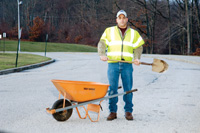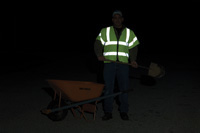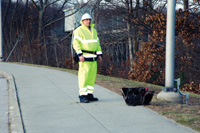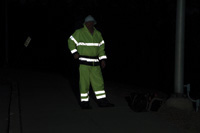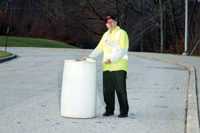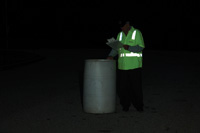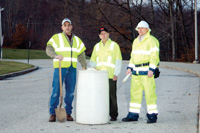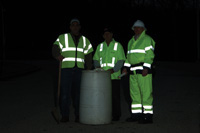|
By Deb Morais Published by the American National Standards Institute (ANSI) and the International Safety Equipment Association (ISEA), the ANSI/ISEA 107-2004 standard specifies performance requirements for high-visibility safety apparel and headwear. The standard was developed in response to workers who are exposed to low-visibility conditions in hazardous work zones. Ultimately, the ANSI 107 requirement was created to save lives and protect workers who are just doing their jobs on America’s roadways. While the existence of ANSI/ISEA requirements for high-visibility apparel and headwear is not new, federal requirements are. Especially noteworthy is that, while the standards previously listed were voluntary, the new standards are mandatory. As of Nov. 24, 2008, very stringent rules were implemented to insure the safety of federal highway workers. Since that date, anyone working in or near federally subsidized roadways is required to wear Class 2 or 3 high-visibility safety apparel; otherwise they and their employer could face citations and penalties. One of the nation’s leading distributors of ANSI-compliant reflective materials opted to respond to the industry’s most recent challenge by providing at least as much information and service as it does products. Metlon Corp., a converter of 3M Scotchlite Reflective Material since 1982, has been a 3M authorized distributor since 2005 and is currently one of only three such companies in the United States. Located in Cranston, R.I., the company that began in the metallic yarn industry in 1947 re-invented itself when that market declined in the United States. Metlon served manufacturers’ unmet and diverse needs for custom slitting, particularly the precision, narrow-width slitting of papers, films and foils as well as the laminations of these materials. This capability, coupled with a stocked warehouse of the most popular 3M reflective products, placed Metlon in a curiously strategic position well in advance of the Federal Highway Administration’s high-visibility requirements and the then-looming November deadline. With the ability to laminate Scotchlite reflective material in single or multiple strips to narrow fabric, webbing and ribbon in addition to plain reflective material, Metlon enabled apparel manufacturers to increase nighttime visibility for construction workers, servicemen and law enforcement officials. Laminated strips of the reflective material have aesthetic value and are used for trim, such as on grosgrain ribbons for cuffs. Familiar applications of this include EMT jackets and vests, which, in many cases, use contrasting colors, such as orange ribbon on a yellow vest or vice versa. Police and fire fighter station wear use laminated and plain roll goods. Metlon also trademarked and manufactured Retroglo, a reflective “yarn” known for its fashion applications as well as its ability to enhance nighttime visibility and safety. While Retroglo does not meet ANSI standards, it was a foot in the door of using reflective materials on more casual, non-work-related apparel. Clearly, supplying manufacturers with reflective roll goods or thinly slit reflective materials for its customers’ own narrow fabrics was integral to Metlon’s business success in the decades prior to ANSI/ISEA. The demand reflected manufacturers’ interest in providing high-visibility, nighttime safety garments and accessories for consumers and employees with and without ANSI standards. Beyond comfort and style issues, the company had already grappled with a host of ongoing practical issues its customers faced for years, from garment laundering to longevity. For example, three laundering options exist and are determined by the materials’ properties, from strictly home washing to industrial washing (of very soiled garments) to flame-resistant industrial wash (for electric workers). Whether from heat-applied laminates to polyester fabrics, or sewn-in reflective material for jackets for its customers, Metlon’s reflective sales during 2008 were fairly evenly split: half from converted roll goods and laminated yarns including Retroglo, and half from 3M Scotchlite Reflective Material. Part of that success came from the company being able to anticipate the surge in demand for its products. Ask Metlon’s Executive Vice President Wayne Etchells about that November 24, 2008, deadline, and he nods and points to the 34-page standard issued by the ISEA, the eight-page 3M “ANSI Made Easy” quick reference guide complete with graphs and illustrations, the 2009 Manual on Uniform Traffic Control Devices (MUTCD) proposed revision document, and a few miscellaneous Internet printouts. “Yes, we’ve been working with ANSI 107 and ANSI 207 for customers for quite a while, primarily Classes 2 and 3,” he says. “Many customers don’t have the time or the resources to study the new worker visibility Final Rule.’ We’ve done our homework so that we can quickly assist customers. Early on, we received requests for help in evaluating needs; it was a sure sign that we should be prepared to inform as well as perform by filling orders quickly.” With ample supplies in stock, routine turnaround is two to three days. Quickly referencing those most-popular reflective items, Etchells rattles off a seemingly memorized list: “3M 8710 Silver heat-transfer reflective film for fabrics, 8910 Silver reflective for sew-on applications, 8935 Silver for flame-resistant applications” trailing off with a few others considered high-gloss or triple-trim materials. With equal speed, he cites anecdotes that underscore the purpose of the “23 CFR Rule” (that’s Code of Federal Regulations, for those not in on the lingo), meant to decrease the likelihood of worker fatalities or injuries by motor vehicles and construction vehicles and equipment. Presenting a one-sheet of the definitions, he emphasizes the importance of both daytime and nighttime visibility for every individual working near the roadway. This relates not only to construction workers but also police, emergency services personnel and even tow truck drivers. After studying the new bible, Etchells notes that apparel design, color, the amount of square inches and placement of reflective material translate into different challenges for each market segment he serves. As a material supplier, not a uniform manufacturer, he often helps specify the new uniform design, based on one of several charts left open on one side of his desk. For smaller uniform shops, he explains the specifications while trying to calculate how to most cost-efficiently meet the standard. Perhaps due to limited need, most of the smaller companies don’t know how to comply. Only after a longer discussion does the bottom line concern become evident. It’s a necessary, if time consuming, proposition for both sides of the conversation. “As the conversation begins, they ask for one-inch wide reflective, and when discovering they need to comply, we guide them to inch-and-three-eighths,” the minimum width for ANSI 107 Class 2, or the Class 3 minimum of two inches. He says, “They approach us knowing what will fit best on the garment versus what’s needed.” With one customer, Etchells fleshed out additional complexities of the ANSI Class 2 standard. The customer had orders for women’s vests in size small. The size of the vest just barely meets the required 775 square inches of background material. Adding the 201 square inches of standard silver grey reflective reduces the visible area of background material to 574 square inches, which makes the vest non-compliant. Based on the customer’s application, Etchells recommends 3M’s Dual Performance Fluorescent High Gloss option, “not only because we’re a distributor, but because that material qualifies as both reflective and background material.” Thus the original background material being covered with the reflective is lost, but the 201 square inches of dual-performance high-gloss replaces it. The lesson: it is not necessary to make a garment larger to compensate for background material when it is covered by standard reflective materials. For Etchells, solving these compliance problems is routine; solving these situations cost-efficiently takes a bit more time. Essentially, the main differences between Class 2 and 3 are: 1) the amount of background and reflective material Class 3 has 60 percent more background and 55 percent more reflective than Class 2 garments. 2) Class 3 garments require reflective sleeves, adding definition to the human form. Pants are not required under Class 3 but further help delineate the human form. Reflective material should encircle the legs. Both Class 2 and 3 must have reflective encompassing the body 360 degrees, to be visible from all angles. While compliance is a hot topic, so is the actual garment to be worn. To one customer, Etchells suggested one of 3M’s new products, Comfort Trim. “It is a segmented, heat-applied reflective material that is primarily used on T-shirts, polo shirts and other light-weight shirts. The segmented design improves vapor transmission keeping the wearer cooler and also improves the drape of the garment making the garment more comfortable.” Etchells and production manager John Caron are up to speed on the requirements, at times managing a phone bank operation to assist customers both before and after the deadline. “There’s been a gradual conversion over the past couple of years. Some have been gearing up for this. Obviously, not everyone has yet converted. In the neighborhood, we noticed Cranston police and crossing guards were in compliance.” Amused, Etchells adds, “You can’t miss the women wearing jackets almost touching the ground.” Joe Otte, 3M’s marketing manager for Visibility & Insulation Solutions, also responded to queries about how women, generally wearing smaller size clothes, manage to accumulate the necessary number of square inches of reflective material required against the fairly wide amount of background material. Admitting that the math doesn’t add up, he acknowledges, “medium and above meets the size requirements. Not small or extra-small [sizes].” Digesting the specifications has been made easier, but Etchells offers an additional word of caution. As in any industry, competition exists. With it comes alternative products with varying degrees of effectiveness relative to cost. Etchells says, “Having certified materials is an element of compliance, and it is no less important than the actual design, reflective, background and combined performance materials.” Essentially, there must be documentation from either an independent third-party laboratory or self-certification through the use of the Apparel and Headwear Compliance Certificate. Metlon provides such a certificate using 3M Scotchlite products. ANSI/ISEA is referred to as the secretariat, or governing body for the standards, but the Occupational Safety and Health Administration (OSHA) is the police. Realistically, the personnel required to proactively check on implementation makes it impossible. However, a federally-funded construction site on a state or local road inspected and documented as non-compliant, or an accident resulting from non-compliance, will have dire financial consequences, such as withdrawn funds and voided grants. Both Etchells and Otte have stories about compliant companies with non-compliant employees. Excuses abound. |
|
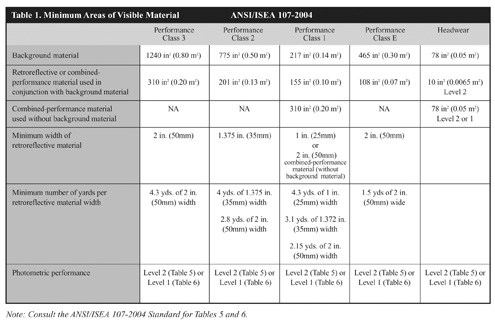 |
|
|
In his marketing position, Otte has identified some trends emerging. Otte says, “More than ever, the end user is buying apparel versus the vest option. In warm weather, those who wear shirts don’t want to add a vest over it. Consequently, we’re seeing T-shirts, jackets, rainwear and sweatshirts as wearable alternatives.” In addition to ANSI 107, there is also ANSI 207-2006, which is not included in this new rule. ANSI 207 refers to a public safety vest, which is now made shorter so that law enforcement agents have better access to their tactical belts. Press coverage, industry events and garment manufacturers have circulated the message of 23 CFR, Safe, Accountable, Flexible, Efficient Transportation Equity Act: A Legacy for Users (SAFETEA-LU). Metlon’s and Otte’s customers had been active prior to the deadline and continue past it. Both men forge ahead, encouraging compliance and referring customers to their respective websites (www.metlon.com and www.3M.com/Scotchlite) for information. At the same time, close at hand is the 2009 MUTCD proposed revision, which promises to expand the rule to cover all roads “open to public travel” as well as to include the ANSI 207-2006 public safety vest as an option. As Etchells says, “Providing outstanding service has been key to our success over these 60-plus years. Looks like it will remain critical in this situation. The standards are a moving target.” |
|
| Above story first appeared in MADE TO MEASURE Magazine, Spring & Summer 2009 issue. All rights reserved. Photos appear by special permission. | |
| Halper Publishing Company 633 Skokie Blvd, #490 Northbrook, IL 60062 (877) 415-3300 Fax (224) 406-8850 [email protected] |
|




